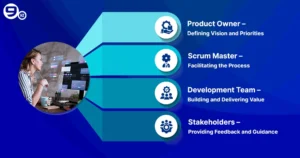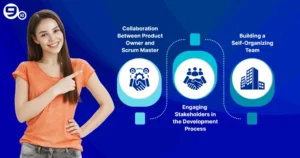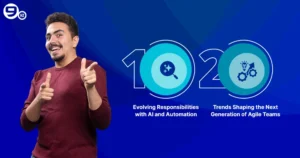Imagine this: two businesses are working on the same idea, but one has launched its software, and the other is still in the development phase. There is no need to tell why the other business will fail. Approximately 70% of projects fail due to delay. Definitely, you don’t want this with your project. This is where Agile Methodology for Software Development comes on the scene.
In today’s fierce market competition, only those companies or businesses that adopt flexible approaches to make their end-customers’ lives easy by delivering software faster survive.
Agile is not a buzzword; it’s a way of working that helps teams quickly adapt to customers’ needs, cut development time, and improve collaboration and productivity. In recent years, the graph of the Agile software development market has risen exponentially(valued at USD 7.82 billion in 2024) and is forecasted to grow to USD 18.46 billion by 2033 at a CAGR of 10.4%(2026-2033).
Whether you’re a product manager, a startup founder, or part of a large enterprise, understanding Agile gives you an edge in delivering real value to your customers.
Considering all the facts and simplifying the concept of Agile methodology for software for entrepreneurs like you, we’ve created a guide here. This guide will discuss what Agile means, the key roles that make it work, future scope, and more. By the end, you’ll know how Agile can accelerate innovation for your company or business.
Introduction to Agile Methodology
To understand the concept completely, let’s explore some basics covering the definition, core principles, and the reason behind its popularity.
What is Agile Methodology?
Agile methodology for software development refers to the iterative framework that breaks down a project into phases called sprints, and the goal is to emphasize continuous delivery and improvement. After every sprint, the software development team reflects, looks back for improvement, and adjusts strategy for the next sprint.
Let’s trace its history a little back!
Have you heard about the “Agile Manifesto”?
This document contains 12 principles and four values of Agile software development. It was published in February 2007 by a group of software development enthusiasts. Now, it is open to all, and the whole technology world is following. Almost all companies, including tech giants such as Amazon, Google, and Meta(formerly Facebook), follow this approach due to its adaptability and ability to launch customer-focused products.
The Agile development lifecycle comprises six stages: requirement analysis and planning, design, development, testing, deployment, and review. It is a circular process and happens with every sprint.
Also Read
Top 10 Benefits of Custom Software Development for Businesses in 2025
Core Principles of Agile
When working on Agile methodology for software development, it’s crucial to understand its core values and principles. Thus, based on the Agile Manifesto, these are:
Four Values
- People over processes and tools: Team collaboration is a priority instead of working individually and developing software using book methods.
- Working software over comprehensive documentation: The key measure is to deliver fully functional software instead of writing comprehensive documents or reports.
- Customer collaboration over contract Negotiation: Agile Methodology for software development encourages collaboration with customers to develop the right product, and contract negotiation is the least priority.
- Responding to change instead of a strict plan: The methodology values adaptability and flexibility over a rigid development plan.
12 Principles
- Early delivery and continuous improvement for high customer satisfaction.
- Adaptability and flexibility to the changes, even late in the project
- Deliver working software frequently, in weeks rather than months.
- Daily collaboration between business stakeholders and developers throughout the project.
- Building software around motivated individuals, providing them with support and an environment to accomplish the project.
- Face-to-face communication and daily stand-up meetings to make communication transparent.
- The key measure of progress is working software.
- The project development pace should be constant and sustainable.
- Continuous attention to technical excellence and good design for enhancing agility.
- Rather than following a complex process, keep it as simple as possible.
- The best architectures, requirements, and designs emerge from self-organizing teams.
- Consistently assess and modify actions to ensure ongoing progress.
Start Your Software Development Project
Talk to our Experts
Request A Free Quote
Why is Agile Popular in Software Development?
Why is Agile everywhere? Here are some top reasons behind the popularity of Agile methodology for software development:
- Flexibility & Adaptability
When the client suddenly changes any requirement, Agile teams can easily handle dynamic requirements or unexpected challenges without panicking, rewriting, and being locked into a rigid development plan. - Faster Time-to-Market
Agile process breaks projects into sprints, which helps deliver projects in weeks instead of months. Businesses can launch their software faster to the market. - Enhanced Customer Collaboration
Agile software development methods enhance customer collaboration at every stage through continuous demonstrations and feedback. This also improves customer satisfaction. - Greater Transparency & Control
Through regular reviews, progress tracking, and open communication, stakeholders have greater transparency and control. - Better Team Collaboration
Agile methodology for software development focuses on active communication and team collaboration, fostering a motivated development culture and improving productivity. - Better Risk Management
Through the frequent review process, risks are identified and mitigated at an early level. This improves the software’s quality and protects it from vulnerabilities.
The Key Roles in Agile Software Development
It’s not only about the process; the roles of people inside the team also play a crucial part in keeping the project on track. Real things happen, and desired outcomes appear when they work together as a team. Therefore, let’s look at the key roles in Agile software development.
Product Owner – Defining Vision and Priorities
The product owner(PO) represents the stakeholder or the voice of the business. Simply, they are responsible for “Why” or “What” of the product. They understand the project requirements and long-term business vision completely and communicate with the development team to set the direction of product development.
Their key responsibilities include:
- Defining product vision and ensuring that the team understands it.
- Prepare next-best action plans taking end-user feedback into account.
- Based on business value, risk, dependencies, and customer needs, they manage backlog.
- Collaborates with stakeholders for feedback, adjusts priorities, and addresses dynamic requirements.
- Accepts or rejects work at the end of each sprint based on the Definition of Done.
The key role of a PO is to ensure that product development drives value to the stakeholders.
Scrum Master – Facilitating the Process
Let’s break the myth that the Scrum Master is a team leader or manager. Most people have this common myth, but that’s not true. The Scrum Master doesn’t manage or lead the team; they are Servant Leaders and coaches for the team, and they are responsible for establishing the Scrum.
Also Read
How Much Does Software Development Cost in 2025?
Here is the breakdown of their responsibilities:
- Coaching and mentoring the team, adhering to the Scrum values and practices.
- Handles administrative tasks such as promoting collaborations(between the Product Owner, Development Team, and stakeholders), conducting meetings, and more.
- Remove obstacles for the team, such as a lack of resources, technical debt, or internal conflicts.
- Facilitates Scrum events, such as sprint planning, daily Scrum, reviews, and sprint retrospectives, to achieve the goal.
- Protecting the team from external distractions and interruptions.
- Helping the Product Owner with product backlog management.
- Coaching, training, and leading organizations for Scrum adoption.
The Scrum Master is like a coach on a football team. While the team focuses on goals, the coach prepares the strategy, removes distractions, and motivates team players.
Development Team – Building and Delivering Value
The development team is not only a team full of developers; it is a cross-functional team that comprises software developers, designers, UX specialists, testers, and quality analysts. The entire team is responsible for developing and delivering the working software through sprints(short iterative cycles), aligning with the business needs. This approach reflects the principles of Agile Methodology for Software Development, where team members are self-organizing with the flexibility to decide how to turn requirements into functional software.
Development team’s responsibilities include:
- Planning and executing sprint work during the Sprint planning.
- Collaborate daily to solve problems and build quality software.
- Conduct testing, integration, and documentation as part of the Definition of Done.
- Participate in reviews and retrospectives to improve continuously.
- Own the technical quality and sustainability of the codebase.
Stakeholders – Providing Feedback and Guidance
Users, investors, business executives, corporate leaders, external auditors, marketers, salespeople, and others are not directly involved with the Scrum team. However, they are considered stakeholders. Their influence on the Scrum team’s decisions and actions is significant, despite the fact that they are not actively involved in product development.
Key Responsibilities:
- Provide feedback during Sprint Reviews and demonstrations.
- Product validation to meet business and user needs.
- Provide domain knowledge or market insights.
- Support decision-making by clarifying constraints or opportunities.
- Helps prioritize features based on strategic goals or ROI.
How Agile Roles Work Together
All Agile roles from product owners to the stakeholders are tight close to each other and follows a collaborative approach to design and develop a unique software. Each role is crucial and related to each other just like a chain. So, let’s understand it how an Agile team collaborates and works together.
Here is how key roles interact with each other:
Collaboration Between Product Owner and Scrum Master
The partnership between Product Owner(PO) and Scrum Master is important for balancing business value with team capability. This collaboration grows with open communication, shared goals, and complementary expertise that results in rapid adaptation and un-interupted delivery.
So, how does it work?
- Backlog: PO is accountable for product’s backlog and Scrum Master assists him through training for handling backlogs effectively.
- Sprint Planning: Their collaboration ensures that the development team starts each sprint with clear goals and a realistic plan by defining sprint goals, clarifying the backlog, and identifying risks.
- Optimization: When collaborating with each other, the PO focuses on enhancing product value, and the Scrum Master focuses on maximizing the Scrum team’s efficiency.
- Scrum Events: Scrum Master ensures that all Scrum Events take place in a positive way on the right time and coaches PO for an effective participation. On the other side PO participates in all events, provide clarity on the product, and make decision accordingly(accept or reject increment in Sprint review).
- Stakeholders: PO manages communication with stakeholders to manage expectations and collect feedback. Scrum Master helps PO for establishing collaboration with stakeholders and feedback-driven approach for product planning.
Engaging Stakeholders in the Development Process
Although stakeholders are the people outside the team, they are part of the ongoing loop. Their critical insights shape the product direction. So, engaging stakeholders is crucial in the Agile methodology of software development. Through frequent communication, the PO invites them for sprint reviews, demo sessions, and backlog refinement. Through a fast feedback team, fix things right away to save time and ensure that the final product is delivered as expected, covering all requirements.
Building a Self-Organizing Team
Key characteristics of a self-organizing team are cross-functional(developers, designers, UX experts, testers, DevOps, etc.), collective accountability, proactive problem solving, and continuous learning. Thus, this team doesn’t wait for permissions; they make their own decisions and decide how to build, test, and deliver in a way that is aligned with the product vision.
Thus, what are the best practices to cultivate a self-organizing team?
- Let the team decide the coding standards, estimate, and split the work.
- Encourage pull-based planning instead of top-down task assignment.
- Create a positive environment for experimentation and learning through failures without blame.
- Always measure outcomes, rather than activities such as hours logged or lines of code.
- Encourage peer mentoring, mob programming, and collective code ownership.
Last but not least, how do PO, SM, and the Team work? PO defines goals and priorities, SM removes obstacles for the team and coaches them, and the Scrum Team decides architecture, tools, coding, and testing strategy to deliver a fine product.
Challenges in Agile Role Management
Although Agile offers many benefits, working with Agile roles is not always simple or free of challenges. Certain challenges are associated with teams, and they must be ready to face these. Let’s have a closer look at what these are.
Overlapping Responsibilities
Agile teams often encounter overlapping responsibilities, and this happens a lot between the Product Owner(PO) and the Scrum Master(SM) or between the SM and the Team.
For example, team members may make decisions without the PO’s input, or the SM pushes the team to meet deadlines instead of facilitating the process or handling the project’s priorities, which is the work of a PO.
It happens due to a lack of clarity or pressure from business leadership. Role overlapping creates confusion, redundant efforts, frustration, and a breakdown of trust between all roles.
For the best outcomes, the overlapping can be resolved with approaches like well-defining role expectations, ongoing training, open communications, workshops, and adjusting workflows.
Managing Distributed or Remote Teams
Co-location is helpful, but it does not ensure fine collaboration as a local team does. Distributed or remote teams face distinct collaboration barriers, such as time-zone differences, weaker team bonding, communication gaps, and misunderstandings.
For example, it is harder to have a quick chat for any discussion related to software development.
Agile methodology for software development involves rapid feedback, clear roles and responsibilities, and strong collaboration. However, from the distributed team’s perspective, it sometimes creates challenges. So, the solution is adopting robust digital collaboration tools, scheduling overlapping work hours for direct communication, using cameras in calls, and increasing transparency.
Scaling Agile Across Large Organizations
Scaling means trying to use Agile rules for a lot of teams working on one big product. This is a very common challenge. A small team of eight people works great with Scrum. But what about 500 people?
When you scale, the simple roles get complex. You might need multiple Product Owners or multiple Scrum Masters. These people then need to work together, which is another meeting. Suddenly, the process feels slow again.
The key is to keep things simple. Use a common way of working across all teams. Make sure the goals of every small team link back to the one big company goal. Additionally, the process should be kept light and not add too many new rules that slow down the real work.
Future of Agile Roles in Software Development
The Agile methodology for software development was introduced in the 2000s and has evolved beyond its previous state; now, it’s not just a way of doing things but the mindset of software development companies around the globe. AI-powered automation is trending, and the jobs of people in Agile teams have been reshaped. Very soon, the teams will incorporate cutting-edge tools powered by the latest technologies, such as AI and Machine Learning.
Evolving Responsibilities with AI and Automation
Artificial Intelligence and Automation are the new normal around the globe, and any custom software development company can combine them with Agile development to achieve better outcomes.
Let’s make it simpler!
- AI can help Scrum Masters(SMs) with tracking process rules and documentation, automating routine tasks, providing data-driven insights for decision-making, improving collaboration, and offering predictive analytics to mitigate risks and optimize processes.
- From the product owner’s perspective, AI will help predict customer behaviour, simplify management, forecast ROI, and auto-prioritize features utilizing machine learning models.
- The responsibilities of the development team involve programming, designing, deploying, testing, and fixing bugs. AI provides solutions for all these tasks, reducing the overhead time in repetitive tasks. This will help them to be focused on solving complex problems rather than spending time on less priority tasks.
You might have a question now in mind: what are the latest trends to be considered for Agile teams? Let’s continue with the blog.
Trends Shaping the Next Generation of Agile Teams
Custom software development services are dynamically evolving, especially within Agile frameworks, to keep up with innovations. Here are some key trends shaping the next generation of Agile Teams.
- AI-Driven Collaboration: AI-powered tools automate repetitive tasks and provide real-time insights. Now, teams have started utilizing AI tools such as Codeium, GitHub Copilot, and others to maintain high coding standards, reduce technical debts, and schedule smartly, enhancing collaboration and accelerating development cycles.
- Hyperautomation & DevSecOps: Hyperautomation will help reduce efforts in CI/CD(Continuous Integration and Continuous Delivery/Deployment), code-testing operations automation, and compliance. Using hyperautomation tools, teams can concentrate on complex tasks like robust architecture design, strategic decision-making, and more.
- Agile and Cloud Native Development: Embedding cloud-native technology into Agile is trending and in near future there will be more advancements into it. Cloud computing benefits Agile methodology for software development development by providing scalability, flexibility, affordability, and enhanced efficiency.
- Cross-Disciplinary Skillset: In near future Agile teams will be cross-functional including experts such as data scientists, compliance experts,and others.
- Remote First and Global Talent: Through the evolution of fast internet, communication and collaboration tools remote first and global talent will be on top. So the teams can be connected and in sync at any time.
- AI-powered Predictive Analysis: Using AI and Machine Learning powered predictive analysis Agile teams will be able to predict project outcomes, risks, bottlenecks, delivery schedules, and resource requirements.
- Quantum Computing: Agile teams have started exploring the potential of quantum computing. This will help them to address security challenges and accommodate hybrid development model using unprecedented computational power.
- Governance and Compliance: Agile teams are adopting software development practices due to environmental concerns. It is happening through aligning with corporate ESG goals, Green Coding, and adopting eco-friendly infrastructure.
Start Your Software Development Project
Talk to our Experts
Request A Free Quote
Conclusion
This blog covered the fundamentals of Agile methodology for software development. Hope you have understood the basics of Agile software development, key roles, challenges, and future scope. Still, for better utilization of this process, you need to ask a question.
Why Understanding Agile Roles is Crucial for Success?
Understanding Agile roles is not about the titles it is crucial to develop and deliver a successful project aligning with business needs. Any confusion and doubt in Agile role may lead to useless efforts or rework or overlapping of the roles that is not accepted at any case when you are upto planning to launch something big.
The concept is simple: PO focuses on value, SM focuses on flow, and Team focuses on developing the product or software.
Final Thoughts on Adopting Agile in Software Development
Adopting agile software development is not just adopting a new process, it is about continuos progress, collaboration, mindset and transforming culture. Remember just one thing and that is Agile is not about perfection it is about progress that leads to a fine product development and delivery. You can start small, keep improving, and trust your team. It will lead your company for long-term success.
FAQs
What are the roles of Agile methodology?
The key roles of Agile Methodology for software development include:
- Product Owner(PO): Defines product vision, handles backlogs, and represents stakeholders.
- Scrum Master(SM): Coach the Team, facilitates Agile process, removes obstacles, and enhances team collaboration.
- Development Team: Cross-functional team comprises of designers, developers, quality analysts, and UI/UX experts which develops a software in collaboration through sprints.
- Stakeholders: From end-users to business leader any one can be stakeholders who provide feedback and requirements to keep development aligned with the goals.
What are the five key concepts of Agile methodology?
Five key concepts of Agile methodology are:
- Iterative Development
- Customer Collaboration
- Adapt to Changes
- Woking Software
- Individuals and Interactions
What role do stakeholders play in Agile development?
The people from outside the Team are called stakeholders such as business leader, end customers, marketing and sales people. They care about the project, provide their feedback, help with decisions, and offer support.
How are Agile roles evolving with AI and automation?
The AI and automations helps PO (Product Owners) for analyzing customer data faster, helping them make better, quicker decisions about the product. Scrum Masters(SM) can utlize it for reading the time to track project and enhance Team’s capability through focusing on their coaching. AI helps Team for automating repetitive checks and testing so they can focus on more innovative tasks.












